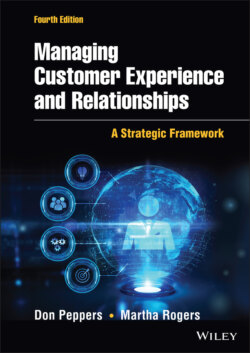Читать книгу Managing Customer Experience and Relationships - Don Peppers - Страница 35
Why Do Companies Work at Being Customer-Centric?
ОглавлениеCustomer-centricity is not always easy, and it's not without controversy. Some believe that employees matter more than customers because without great, engaged employees, an enterprise will have a hard time building strong customer relationships and building customer equity. Others continue to focus on cash flow and on making sure that strong product managers are held responsible for product promotion, distribution, and profitability. Ad agencies continued to tend brand promise. But while all of these are important to a successful business, a growing number of firms have recognized that three things are true about a company's customers. Because of these truths, a company stands its best chance of success when it focuses on increasing customer value through outstanding customer experiences and relationships.
1 Customers are scarce. There are successful organizations that do not have products, but there is no such thing as a successful firm that doesn't have customers. Despite the fact that the world has billions of people, only so many of them will ever want a particular company's offering. That company's ability to find them, win them, get as much business from them as possible, and keep them for a long time will be the determining factor in how much it can ever grow the size of its business. There are only so many hungry people, right now, within reach of a neighborhood pizzeria, and each of those people can cook for themselves, or go to a competitor, or start a diet today. Customers are scarcer than products, services, new ideas, or channels. For all but those companies in real financial trouble, customers are even scarcer than capital itself. There is no secondary market for customers. They can't be borrowed at the bank and paid back with interest. Once a company's leaders realize this fact, they may make decisions differently, as we will see in Part III.
2 Customers are the sole source of all a company's revenue. Products don't pay a company any money, ever. Neither do brands or services, or employees, or marketing programs, or stores, or factories. Only customers generate revenue for a business—the customers the business has today and the customers it will have in the future. All the other stuff is important to a business only to the extent that it contributes to generating more revenue from customers. Thus, the goal will not just be to create value from each product or channel or even the greatest return on the investment of money, but instead to make sure the company creates the greatest value from each of its customers.
3 Customers create value in two ways. Today, they are generating profit this quarter (or not), and—also today—the experience they are having with a particular company's product, its brand, its contact center, or any of the rest of what it is selling is also causing them to become more (or less) likely to do more business with the company in the future, to become more (or less) likely to recommend it to friends, to think kindly of it (or not) when they need something else in its category. It's interesting that nearly every company is very, very good at measuring and managing one way that customers create value: Companies know how much they spent making money from customers this quarter and what their revenue was from customers this quarter—since that's the total of the cost and revenue on the quarterly books. But many companies are content not to know the second part of this equation: They don't know, don't measure, and don't manage what is happening to underlying customer equity while the current numbers are falling into place. That means understanding a company's Return on Customer (ROC)30 is as important as understanding its return on investment (ROI).31 We talk a lot more about ROC in Chapter 11.32
ROI answers the question: How much value does your company create for the money it uses?
ROC answers the question: How much value does your company create from the customers it has?
